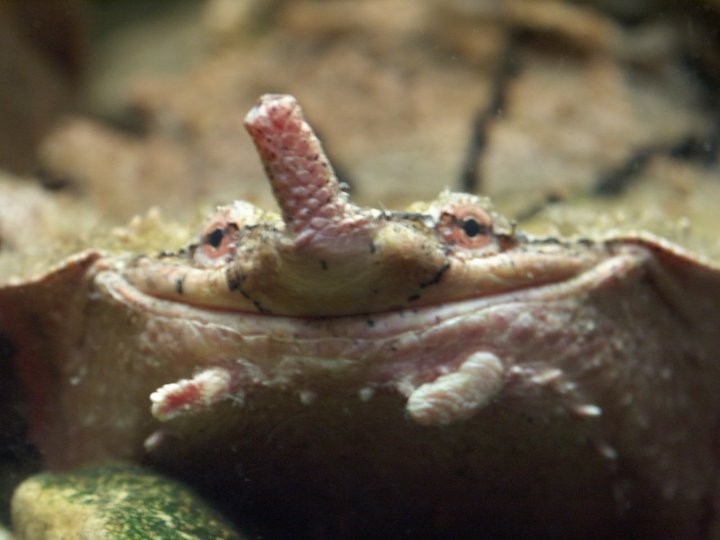|

| Name: Matamata Turtle. |
| Scientific Name: Chelus fimbriatus. |
| Family: Chelidae (suborder Pleurodira) |
| Genus: Podocnemis |
| Range: Northen South America. |
| Status: Not Endangered (yet) |
| Habitat: Rivers basins (Most common found in the Orinoco and Amazon rivers). |
| Diet in the wild: Fishes, amphibians, freshwater crustaceans, possibly birds
and small mammals. |
| Diet in the zoo: Fishes, water plants, small crustaceans. |
| Location at the zoo: Herpetarium |
Physical Description:
 The Matamata is one of the largest freshwater turtles. An adult age turtle could reach a shell size of
18 inches. Its flat head is connected to a long neck which presents many protuberances, warts and ridges. Its
scutes have a conical shape and they are determine by well formed symmetrical rings. The mouth is wide and the snout
is long. Matamata's eyes are very small and they are located by the snout. The Matamata is one of the largest freshwater turtles. An adult age turtle could reach a shell size of
18 inches. Its flat head is connected to a long neck which presents many protuberances, warts and ridges. Its
scutes have a conical shape and they are determine by well formed symmetrical rings. The mouth is wide and the snout
is long. Matamata's eyes are very small and they are located by the snout.
The Carapace and
neck color vary from a dark brown to a mahogany; while the plastron has a salmon color. With the time, the salmon color
changes on the plastron to yellows and browns. The throat on the young has a reddish brown color and eventually will
change to a tan brown. (Matamata)
|
Habitat:
The Matamata lives on the north part of South America, around the Orinoco and Amazon rivers
on both Venezuela and Brazil respectively. They spend most of the time on the water walking around the bottom.
(Reptiles of the World)
They actually breath thanks to their long necks that
extend the snout tip over the surface of the water. Matamatas prefer calm and slow moving waters that most of the time
are very turbid. (Matamata) |
Food and Feeding Techniques:
Matamatas are well known for looking their food during the night on the island of Trinidad. Among their
diet is found: fish, amphibians, freshwater crustaceans, possibly birds and small mammals that get into the water. The
Matamata hunting technique is unique among the chelonians. While opening their mouth and expanding their throat, the
Matamata extends the head up and catch their prey. These movements, made at the same time, create a suction action
that draws the prey to their long and expanded throat; the pray is swallowed and the water is expelled out. (Grzimek'sAnimal
Life Encyclopedia) |
Comments about the Matamata:
The Matamata of South America is a very interesting and probably the most diverse in form of all the
turtles. Their flat head seems triangular because of extensions of the skin found in both sides; a flexible snorkel
is located at the end of the head. Three rows of large humps cross their flat back. The posterior part of their
eyes are lined with a crystalline wall (a tapetum lucidum) which makes the light reflect; a similar characteristic is seen
in crocodiles and other nocturnal reptiles. (Reptiles of the World). "A full-grown Matamata
with a shell 18 inches long appeals to the human mind more like a vision of a disordered dream than a living reptile." (Grzimek'sAnimal
Life Encyclopedia, p.119) |
|
Personal Observations:
The Matamata is one of nature's unique species that stands in a genus by itself. It is a fascinating
animal that displays numerous exotic features. One is their peculiar technique used for hunting their prey.
They actually suck the fishes into their throats, and at the same time they expelled the water out. The Matamata is a turtle
but also it has many properties or characteristics that have been compare to those of crocodiles. If we take a close
look to this turtle we will find many features similar to the features of a crocodile. |
|

